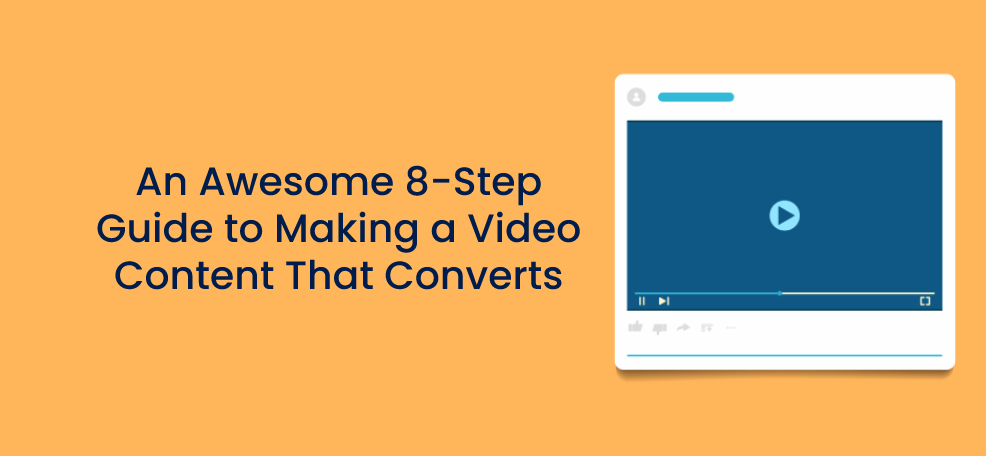Video marketing has now become an essential strategy in every savvy marketer’s overall content campaigns.
Not only because today’s customers love the type of content, but it also makes it much easier for marketers themselves to get their message across. It should come as no surprise that more than 86% of marketers use video content to achieve their marketing objectives.
But, of course, not all videos are created equal and worked the same. Only well-crafted ones bring the results you’ve expected– while the poor-quality ones can scare your audiences away and even harm your online reputation.
Well-crafted marketing videos here are so much more than videos that cost hundred-thousand bucks, look extremely realistic, and have the highest resolution where you can see all the details.
Rather, well-crafted marketing videos can convince your audiences to take action, bringing you an increased conversion rate. Done right, a good marketing video can raise conversion rates by up to 80%.
Now, the question is, “how can you create a video that converts, then?”
We’ve listed some handy best practices to help you craft your marketing videos so they can convert the viewer into a lead, as well as a lead into a loyal customer.
#1. Define Your Objectives
There’s no such thing as one-size-fits-all videos. Each video has its own way of helping you achieve a specific goal. So, before you even begin scripting your video, take a step back and think about what you want to achieve with it.
Without knowing your objectives, it would be difficult to measure the success of your video marketing campaign.
Are you looking for brand awareness? Do you want people to sign up for your email list? Or are you hoping that they will make a purchase?
Once you know your objectives, it will be much easier to come up with an easy-to-track video strategy that aligns with them.
For example, short and appealing videos like explainer videos are a good option if you want to boost your brand awareness. That is why videos make good content on video pop ups.
Meanwhile, if you want to gain trust, a video that shows social proof like a customer testimonial video is one of the best options.
Also, by defining your goals or objectives for the video, you know what metrics you should pay attention to. View rates, completion rates, social shares and more can give you insights into how well your video is doing in achieving its objectives.
#2. Understand Your Audiences
The next step is to understand your target audiences. Remember that you create video content for your audience, so make sure you make the content all about them. Viewers only take action if they feel that the video is addressing their needs.
Therefore, make sure you do research about your target audience, including their demographics (location, age, gender), interests, what type of content they usually consume, and even what devices they use most often to watch videos.
The more you know about them, the easier it will be to create a video that resonates with them and drives them to take action.
You can use the information when scripting the video, selecting visuals and music, as well as developing the overall tone of the video.
Understanding your audiences would also be much easier for you to understand their pain points and craft a video that can offer them the solution they are looking for.
#3. Focus on Problem Solving and Avoid Hard-selling
People hate being sold to. That’s why using a video to brag about your awesome features no longer works. If viewers feel that the video is nothing more than an extended commercial, they are likely to lose interest and move on.
After all, in this fast-moving world, one of the main reasons a viewer wants to convert is that they feel the video is addressing a problem that they are experiencing.
So, when you write your script, make sure you show your audiences that you understand their pain points and have the solution to offer, they will be more likely to take action. This is where the power of storytelling comes in.
That’s the beauty of video content: it has the power to tell a story with a combination of visuals, audio, and emotions that can connect with the viewers on a deeper level.
Storytelling allows you to present your product or service in a way that is more human and relatable, which can help build trust with your viewers. Plus, it also helps keep their attention glued to the video until the very end.
#4. No Fluff, Only Meat
Do you know that a human’s attention span is only 8 seconds? Yes. It’s a little bit shorter than a goldfish– which is 9 seconds. And one thing is clear here: keeping your videos short and straightforward is crucial more than ever.
Nobody has time to watch a long and meandering video. According to the statistics, a viewer will stop watching a marketing video at the 2-minute mark.
That’s why it makes sense that a study shows a video with the highest engagement is a video that has no more than 120 seconds.
This doesn’t mean you have to skimp on the content or cut out all the details. It just means that you need to be strategic about the way you present them.
You can do this by boiling down your main message into a short, catchy headline or using subtitles to help get your point across quickly.
You can start your video with a thought-provoking question or an interesting statistic to hook the viewers in and offer them a solution using your product or service.
#5. Keep the Videos Visually Consistent
Video marketing can be such a powerful tool to show off your brand colors, logo, fonts, and style.
When viewers see a video that is visually consistent with other marketing materials they’ve seen from your brand, it can help them quickly identify that the video is produced by you. This can help to increase brand recall.
Check if the fonts, colors, and transitions work together. It’s always best to be purposeful with your visual elements.
When everything works well and is consistent altogether, it can help to create a more polished and professional look. This, in turn, will make your brand more trustworthy.
#6. Don’t Forget the CTA
No matter how brilliant your video content is, if you don’t tell your viewers what they should do next, all your efforts will be for naught. This is why you should never forget to include powerful call-to-action (CTAs).
Your CTA should be clear and concise, telling viewers what you want them to do next. It could be anything from visiting your website to watching your other, relevant videos or even downloading a white paper.
You can use voice-over to communicate your CTA, use text displayed on the video, or write it down in the description box or end cards (if you use video hosting platforms like YouTube).
#7. Choose the Right Video Hosting Platform
Your video marketing strategy isn’t all about video production. You also need to think about where you’re going to host your videos so they can get the limelight it deserves.
From social media to your own website, there are a lot of video-hosting platforms out there, but not all of them are created equal. Some platforms are better for SEO than others, while some offer more features and tools that can help you with your video marketing efforts.
You also need to consider the audience you are targeting. For example, if you’re targeting a global audience, YouTube would be the best platform for you. If your target market is more B2B, then LinkedIn might be a better option.
In other words, find a place where your target audiences spend their time online the most. Then, you can host your videos there so that you can reach out to them.
#8. Pay Attention to SEO
Just like with any other type of content, you need to optimize your videos for SEO. This means that you should consider:
- using a keyword-based title and descriptions
- including closed captions
- optimizing your videos for mobile devices
- creating eye-catching thumbnails
- creating transcription or closed captions for your videos
All the points mentioned above will make your videos much easier to find as they are better on SERPs, like Google or YouTube.
You can also embed your SEO-friendly videos on your website or blog to help you get more traffic.
#9. Learn From the Analytics
This is probably an often-overlooked step in the video marketing checklist.
Robust video hosting platforms provide you with analytics features. Even social media like Instagram has Instagram Insights, and YouTube also comes up with the YouTube Studio Analytics feature.
With all the data on the analytics, you can get a lot of valuable insights into how people are interacting with your videos. This information can help you to improve your video marketing strategy and make better videos in the future.
Use the analytics data to determine:
- the type of videos that are most popular.
- which channels are getting the most views.
- where viewers are dropping off.
- what CTAs are working the best.
- which keywords are being used to find your videos.
By understanding how people are interacting with your videos, you can make better, more effective videos that will help you achieve your business adjectives.
Wrapping Up: Start Your Video Marketing Today
There you have it. A comprehensive guide to starting your video marketing today. Thanks to the internet, now you can create high-converting videos with easy-to-use online video tools– no superb editing skills required!
That said, just remember that Rome was not built in a day, and the same goes for successful video marketing campaigns.
It will take time and effort to create high-quality videos that people will love and want to watch over and over again. But with a bit of determination and these best practices, you’re well on your way to creating videos that will help you achieve your business goals.
To ensure you didn’t miss any essential process while running your high-converting campaigns, we’ve included a quick video marketing checklist:









